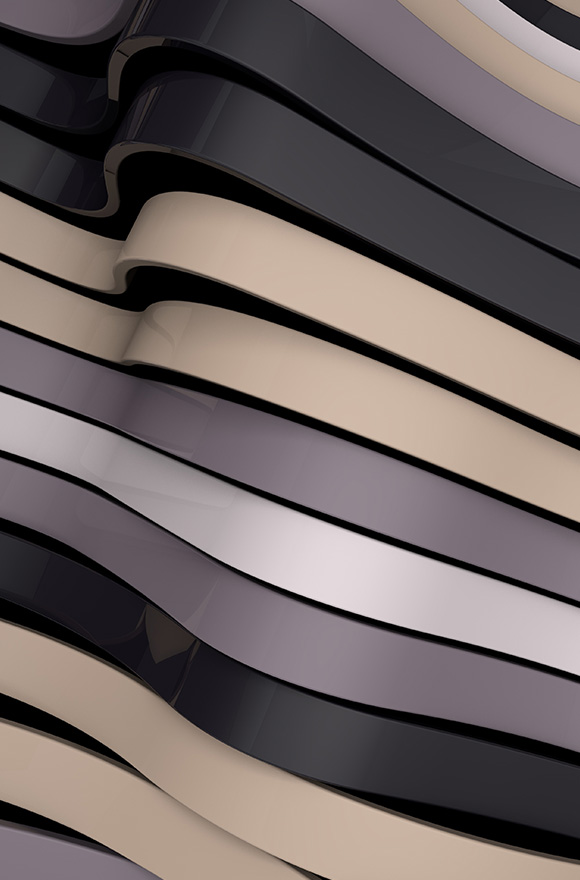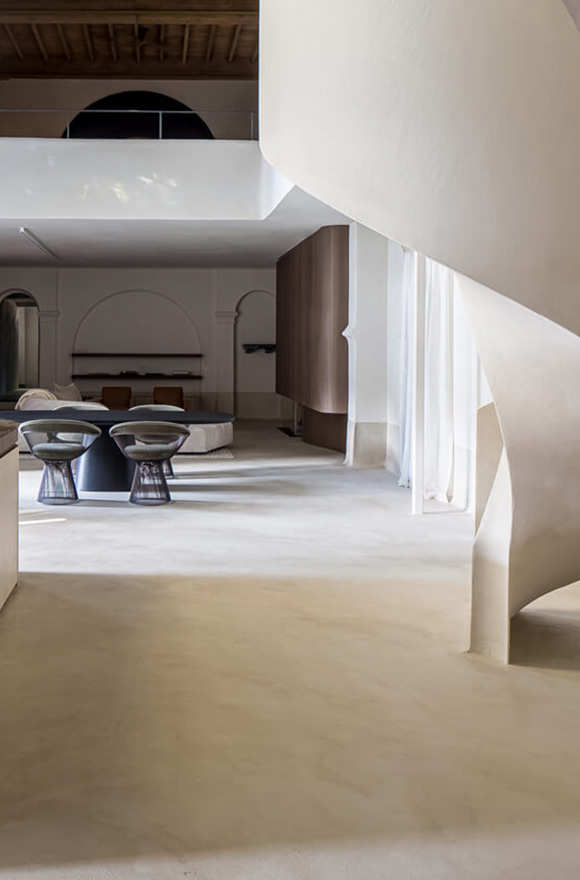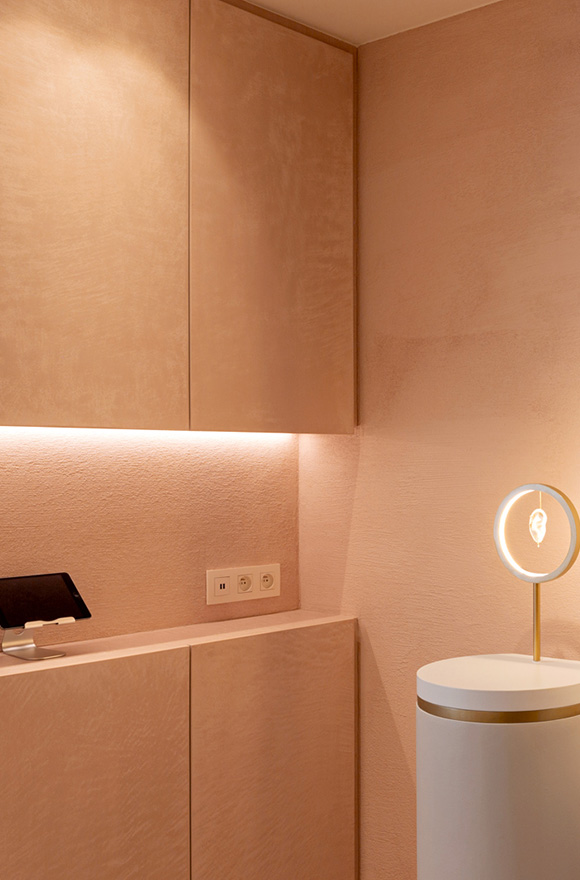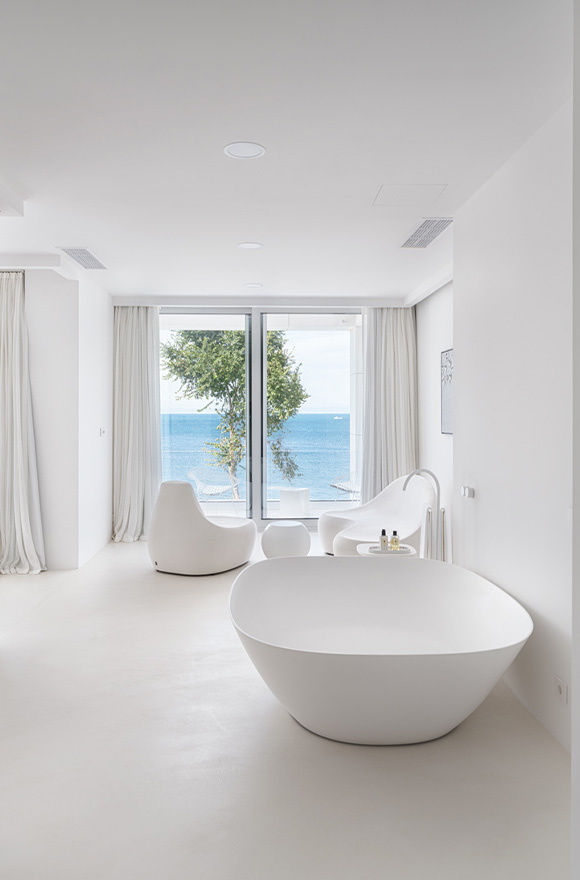Microcement in new construction: beyond conventions
Microcement is no longer just a sophisticated technical material that has consolidated in modern construction. Today it is truly a design tool. Behind its growing success, however, there is much more than versatility or the possibility to apply it on pre-existing surfaces. To truly understand the value that this material brings to contemporary projects, we decided to analyse it with a new, critical lens.
Metamorphosis of material: an “architectural skin”
One of the least explored aspects of microcement is its ability to transform into a surface that behaves like an architectural “skin”, and adapts perfectly to shapes and geometries.
Microcement follows, envelops and enhances curves, corners and irregular surfaces, creating a highly impactful aesthetic effect. This quality makes it particularly interesting for unconventional design projects, where extreme customisation and the ability to adapt to complex structures are required. In this sense, microcement should not be seen as a finish, but rather as an active element of the project, which interacts with shapes and amplifies their character.

The thermoregulatory potential of microcement
Although microcement is best known for its aesthetic qualities, its ability to contribute to the thermal comfort of environments is less known. Thanks to its mineral nature and the possibility to be applied in very thin layers, microcement behaves like a material that reacts to temperature changes. When used in combination with underfloor heating systems, for example, microcement contributes to distributing heat homogeneously. This feature makes it a particularly interesting choice for new buildings, where attention to energy efficiency has become a priority.
Microcement and acoustics: an unexpected connection
An underrated aspect of microcement is its impact on the acoustics of spaces. In large spaces or spaces with hard surfaces, such as open spaces, offices and lofts, sound reverberation is one of the most common problems. Although it does not have specific acoustic properties, microcement avoids joints or discontinuities that can amplify the rebound of sound waves. With the right techniques, if combined with specific insulation systems or other sound-absorbing materials, it can be used as part of an integrated sound control system, especially in large spaces, without sacrificing aesthetic sophistication.

Revolutionising construction processes: reducing waste and turnaround times
Because it can be applied in thin layers, microcement significantly reduces the amount of material needed. This leads not only to a lower environmental impact, but also to a logistical simplification of the construction site, with a reduction in the time and costs associated with waste disposal.
New application technologies allow the use of increasingly advanced equipment that improves efficiency and precision in the application of microcement, further reducing processing times. This operating speed represents a significant advantage for new constructions, where compliance with deadlines is essential.
Interacting with light
The ability of microcement to interact with light is a subtle element that nonetheless greatly affects the perception of space. Depending on the chosen finish, whether matt or glossy, microcement can create reflections that modify the perception of space, enriching the visual experience of environments. Microcement’s seamlessness allows you to play with light and shadows in a uniform way. In design projects, this feature offers infinite possibilities to enhance brightness.

Microcement and domotics
In the context of new construction, where technology is increasingly integrated into living spaces, microcement represents a material easily compatible with home automation and smart home systems. Its uniform and seamless application allows you to hide sensors, wiring and other technological elements without compromising aesthetics.
Multisensory applications: experiential design
In contemporary architecture there is a growing attention to experiential design, namely that which involves all the senses. Microcement surfaces can be modelled and treated to create particular textures that enrich the tactile experience. It can be applied with matte, satin or rough finishes, each providing a different texture and feeling, favouring immersive and sensorial design. This possibility opens up new scenarios, particularly in commercial, exhibition or museum contexts, where the interaction between user and environment becomes an integral part of the architectural narrative.

Microcement in hyperfunctional environments: from industry to healthcare
Although it is mainly associated with residential or commercial interiors, microcement is increasingly finding application in hyperfunctional environments such as hospitals, laboratories, industrial kitchens or areas with high mechanical and hygienic use.
For example, in areas where sanitisation of the environment is essential, the absence of joints eliminates one of the main weak points in terms of dirt and bacteria accumulation. Resistance to chemical agents, in addition to the implementation of antibacterial or antimicrobial finishes, also makes it an interesting option for spaces intended for food or pharmaceutical production, where hygiene regulations are particularly stringent.
Microcement in the future of construction
In a world increasingly attentive to sustainability, technological innovation and well-being, microcement emerges as one of the most flexible and advanced options for new constructions. It is a material that becomes a multifaceted tool, capable of transforming spaces.